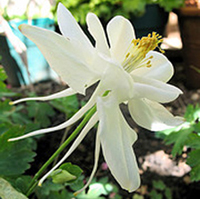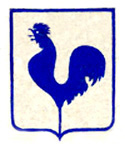 |
Stories & Legends
Naivety or a Higher Understanding of Things?
Elaine Marie Jordan
In the Middle Ages the men of science studied nature with the scrupulous care that Catholics should have for the works of God. They did not consider it a body without a higher life. They always sought to find the mysterious relations between nature and the duties and beliefs of man redeemed by the Savior. They saw the habits of animals, the phenomena of plants, the singing of the birds, and the properties of precious stones as symbols of the truths taught by the Faith. The proud and empty present day nomenclature still had not invaded and spoiled the world re-conquered by the Church to the True God.

The medievals called it the Trinity Flower, for the three painted petals recalling the Holy Trinity

The columbine recalled the dove, the symbol of the Holy Ghost

The medievals called it the "eyes of the Holy Virgin" |
On Christmas Eve, the medieval man would go to the forest to announce to the trees the birth of the Savior, singing Aperiatur terra et germinet Salvatorem [Let the earth be opened and bud forth a Savior]. In return, the earth should produce roses where man shed blood, and lilies where his tears fell. When a saint would die, the flowers of the area would feel obliged to wither, or at least to droop when the funeral procession passed…
When the poor man raised his eyes to heaven at night, it was not the Milky Way of Juno that he saw, but the road that would guide his brother pilgrims to Compostella. The medieval Spanish name for the Milky Way is the El Camino de Santiago, the Way of St. James, the road in the sky that pointed the way for pilgrims to Compostela. Or the simple peasant called it the pathway that the blessed would take to go to Heaven.
Above all, flowers offered a world peopled with the most charming images in a silent language that would express the most tender and lively sentiments.
The Catholic people, together with the men of learning, gave to these sweet objects of their daily attention the names of those whom they loved, that is, the Apostles, their favorite male saints, the female saints whose innocence and purity seemed to be reflected in the beautiful limpidness of the flowers.
Mary Most Holy, that Flower of flowers, that Rose without thorns, that Lily without stain, had an uncountable legion of flowers that were enhanced and made more beautiful in the eyes of the people by having her sweet name. It was as if these flowers were her relics, spread everywhere and always renewed.
The great wise men of our days, however, have preferred to replace her memory with that of Venus. Let us cite only one example of the gross materialism that characterizes today’s nomenclature: Who does not recognize the enchanting little flower known generally in France as the “eyes of the Holy Virgin” [the forget-me-not]?
According to a beautiful and pious medieval legend the Christ Child was sitting on the Blessed Virgin’s lap one day. Desiring that future generations could see her beautiful eyes, He touched them and then waved his hand over the ground and blue “eyes of the Holy Virgin” [forget-me-nots] appeared.
Modern pride preferred to exchange this name for myosotis scorpioides which literarily means, “the ear of the rat with an air of the scorpion.” And this is what is called scientific progress!

Based upon and translated from the
History of Saint Elizabeth of Hungary,
Charles de Montalembert, pp. 156-157


Related Topics of Interest
 Red, White and Blue Red, White and Blue
 The Middle Ages, a Forest Filled with Symbols The Middle Ages, a Forest Filled with Symbols
 The four Beasts of the Gospel The four Beasts of the Gospel
 Gargoyles and Original sin Gargoyles and Original sin
 Vice and Vice Symbolized in Animals Vice and Vice Symbolized in Animals
 Snowflakes Reflect the Diversity of God Snowflakes Reflect the Diversity of God

 
|
Legends | Religious |
Home | Books | CDs | Search | Contact Us | Donate

© 2002-
Tradition in Action, Inc. All Rights Reserved
|
 |
|